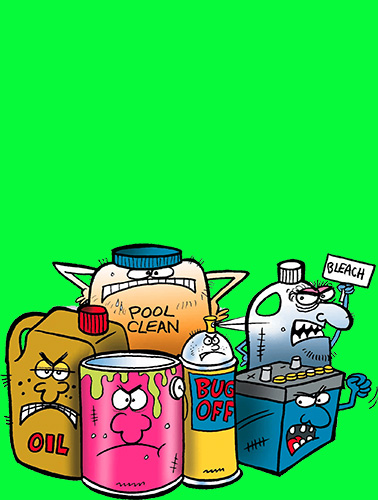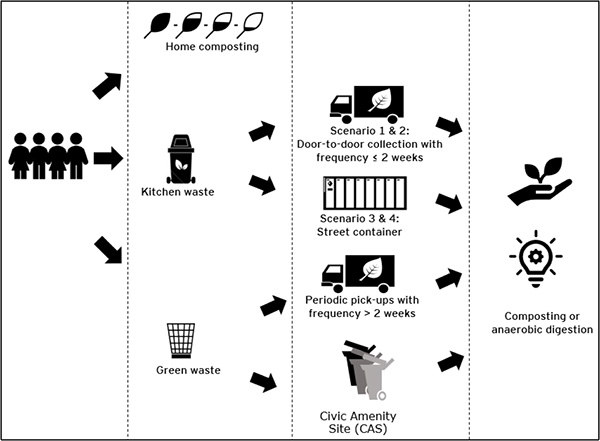
Household Hazardous Waste
Hazardous waste may be divided into two basic groups: characteristically hazardous wastes and listed hazardous wastes. These are waste types that are hazardous because they exhibit a certain physical property or characteristic. Hazardous waste is the waste which possess one or more of the following hazardous properties: explosive, oxidizing, flammable, irritant, specific target organ toxicity, acute toxicity, carcinogenic, corrosive, infectious, toxic for reproduction, mutagenic, release of an acute toxic gas, sensitizing and ecotoxic, as defined in the EU Waste Framework Directive (WFD) 2008/98/EC amended by Directive (EU) 2018/851. Also, wastes are considered hazardous if they are listed under the Classification of Prescribed Hazardous Wastes (HW), European List of Waste (LoW), Decision 2000/532/EC. Non-hazardous waste is the waste which do not display any of above-mentioned hazardous properties and which are listed in the EU LoW as non-hazardous waste.Hazardous waste poses a greater risk to the environment and human health than non-hazardous waste and therefore requires a stricter control regime, separate collection and special treatment. According to the WFD, additional labelling, record keeping, monitoring and control obligations from the "cradle to the grave", in other words from the waste production to the final disposal or recovery of the hazardous waste, are required. The WFD also bans the mixing of hazardous waste with other categories of hazardous waste, and with non-hazardous waste.
The LoW is a document that establishes a harmonized classification system for waste within the EU, including a list of hazardous and non-hazardous waste. Each type of waste is assigned a six-digit code, while hazardous wastes are also marked with an asterisk (*). The classification into hazardous and non-hazardous waste is based on the system for the classification and labelling of dangerous substances and preparations. This ensures that similar principles are applied over the whole life cycle of materials.
Hazardous waste that is produced by households, that is Household Hazardous Waste (HHW), such as hazardous waste from Hazardous Household Chemicals (household cleaning and personal care products; paints, varnishes, inks and glues; household and garden pesticides; photo-chemicals; packaging), Domestic Healthcare Wastes (unused pharmaceutical products, sharps and other potentially infectious waste), Construction and Demolition Waste (asbestos waste, treated wood, coal tar and tarred products), Automotive Maintenance Waste (automotive products, surface polish, brake fluids and anti-freeze fluids, contaminated absorbing materials and used oil filters), Mercury-Containing Waste other than WEEE, some of WEEE, batteries and accumulators, waste oils, should also be collected separately to avoid contamination of municipal waste with hazardous waste fractions that could lower recycling quality and to ensure environmentally sound management of that hazardous waste. By 1 January 2025, the EU Member States are obliged to set up separate collection for HHW. In the EU, the reported volumes of HHW range between 1 and 6 kg per inhabitant per year.
HHW is mainly collected at stationary CAS, typically around two-thirds, in the EU countries. About one-third is collected via mobile collection (mobile CAS) and periodic pick-ups. CAS are key collection facilities for the large diversity of potential HHW streams, but user-friendliness is key: long opening hours, accessible locations and a high-density CAS network increase the collected volumes of HHW. Distance from households (and potentially from small commerce, small-scale industries, institutions, small business, etc.), should not be more than 7-8 km. Furthermore, collection points within retail shops exist for some waste streams such as batteries, small electronic appliances.
Both the characteristics and the management of HHW categories differ substantially. However, the collection facilities for HHW can be grouped as illustrated in the figure below.

Figure 1: Separate collection for Hazardous Household Waste (HHW)
If door-to-door services are provided for HHW, the collection costs increase, but the collection rates also, especially in densely populated areas. Periodic pick-ups and mobile CAS can overcome space constraints in densely populated areas. However, the periodicity and locations of HHW collection facilities need to be well communicated via conventional channels as well as by user-friendly digital tools to make it as easy as possible for households to return HHW.
In addition to CAS and periodic pick-ups, local authorities and Extended Producer Responsibility (EPR) collection schemes can foresee user-friendly collection channels via in-shop take-back and on-demand collection from homes. For certain HHW such as asbestos, local authorities can minimise health risks and illegal disposal by providing stream-specific services, e.g. collection of bound asbestos from homes in a standardized packaging.
The mobile CAS usually stays on certain dates at the same public location for a half day. The frequency of service depends on local circumstances and varies from once to seven times a month. Several fractions can be collected including construction and demolition waste, WEEE and wood. The service is normally provided without a fee to citizens. Waste from companies is not accepted at the mobile CASs.
Although the costs will differ substantially depending on the HHW stream and the location, the following cost ranges give an indication of the order of magnitude: stationary CAS: 0,1-1,7 €/kg; door-to-door: 1,7-10 €/kg; take-back systems: 2-3 €/kg; mobile pick-ups: 2-10 €/kg. Municipalities from different European countries report that the overall cost of HHW management ranges between 200 and 2000 €/ton.
The cost of a stationary CAS is assessed at about 75 €/ton in the EU countries. The HHW collection system is mainly funded by the local authorities and amounts to about 2 € per capita for both the mobile and stationary CAS. Stationary CASs require a much larger upfront investment than one-day collections, but costs per participant are lower for the municipality in the long run. Also, within CAS, a dismantling and recycling centre can be established. In this centre some waste, mostly WEEE, can be repaired, recycled, reused and upcycled. People can exchange waste, buy repaired or recycled WEEE, etc.
In-shop take-back collection can be applied for WEEE, batteries, accumulators, pharmaceutical waste, waste oils, etc.; free of charge. In order to establish this way of HHW collection, legal decisions on EPR schemes must be adopted. The take-back facilities offer user friendly solutions for consumers with no or little extra transport needed. The local self-governments have to publicise these collection points as part of an overall HHW management strategy. Retailers have to be obliged, according to legal decisions, to implement in-shop take back programmes in medium and large stores and voluntarily in smaller shops. Usually the take-back systems of HHW apply to:
- Large electrical appliances, refrigerators, display screen equipment, small electrical appliances and gas discharge lamps (buy new appliance, hand in old appliance);
- Batteries (exact designation: used appliance batteries);
- Expired medications and medical products.
Treatment of HHW comprise HHW reuse and recycling (paints, varnishes, inks and glues, photo-chemicals, contaminated absorbing materials and used oil filters, automotive products, surface polish, brake fluids and anti-freeze fluids, mercury-containing waste other than WEEE, WEEE, batteries and accumulators), incineration at high temperatures (usually household cleaning and personal care products, paints, varnishes, inks and glues, household and garden pesticides, unused pharmaceutical products, sharps and other potentially infectious waste, treated wood, coal tar and tarred products), chemical treatment (electrolysis of photo-chemicals, steam sterilization or chemical treatment of sharps and other potentially infectious waste), energy recovery (waste oils), and, as final step, disposal in the landfill for hazardous waste landfilling (asbestos waste for which stabilization measures have been taken before landfilling, household and garden pesticides-less favourable than incineration, coal tar and tarred products-less favourable than incineration, mercury-containing waste other than WEEE which is generally treated and stabilized before it is permanently disposed).
In parallel with HHW collection and establishment of stationary CASs and/or mobile CASs, continuous education and awareness about Household Hazardous Waste risks, prevention and proper management have to be implemented by all public authorities, including municipalities.